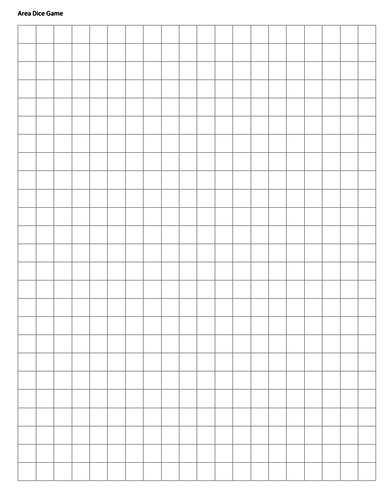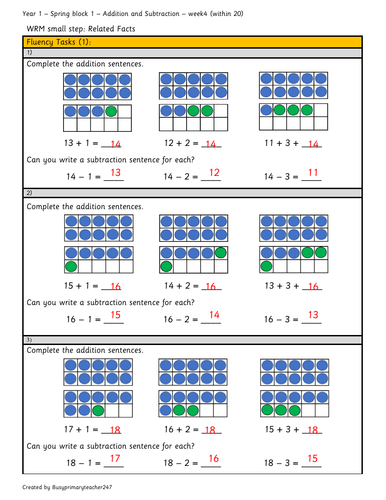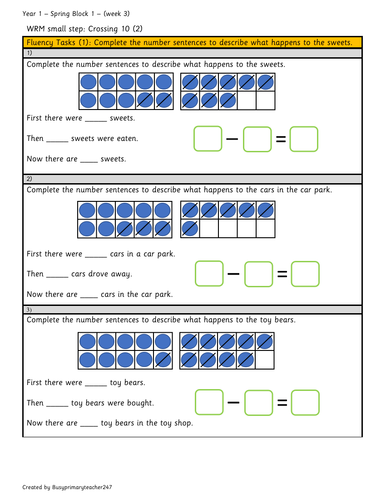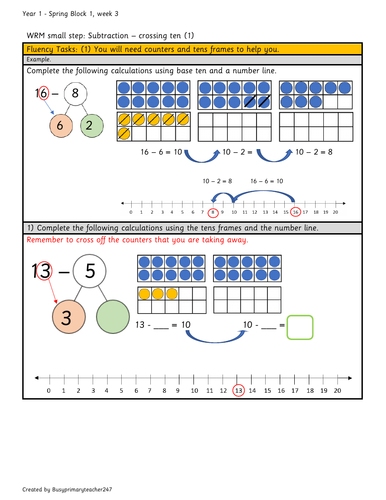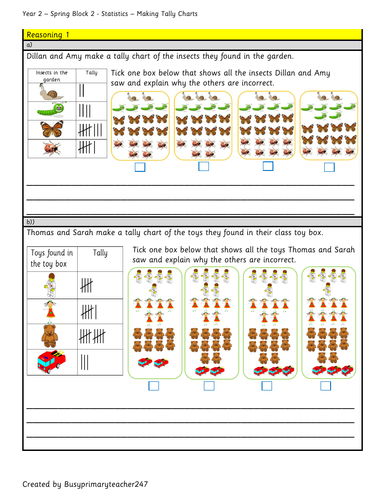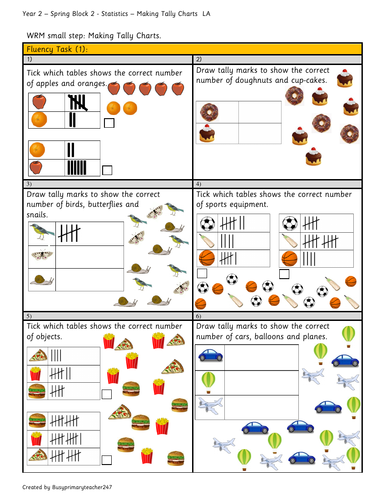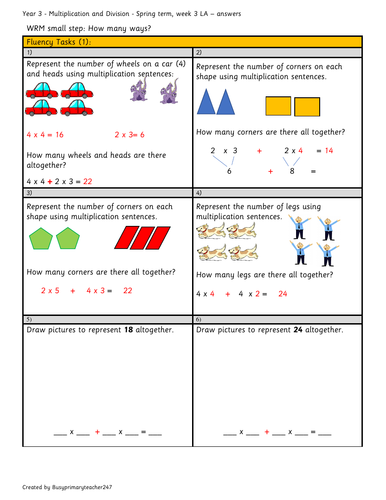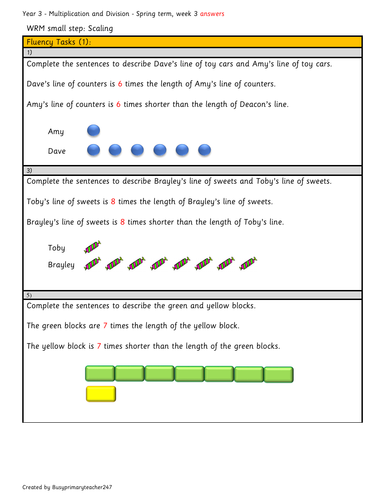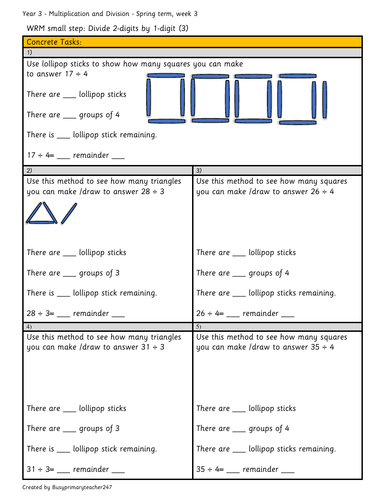132Uploads
174k+Views
66k+Downloads
All resources

Year 4 - Spring Block 2 - Measurement - Area (week 4)
These resources link directly to WRM Spring block 2, Measurement - Area (week 4) and the first step: What is area?
The dimensions for the 5cm and 10cm squares prints out as close as I can get it (just 1-2mm out).
I've also included an 'Area Dice Game' as a free bonus activity for fast finishers or a warm-up activity.
Curriculum links:
- Find the area of rectilinear shapes by counting squares.
I hope this resource is useful, the remaining small steps for week 4 will be released as soon as I can create them :)
Your feedback is always welcome x

Area Dice Game
This is a great game for 1-2 players.
Equipment
-squared paper
-2 dice
-coloured pencils/ felt tips (textas)
Instructions
- Each player chooses a different coloured pencil / felt tip
- Players take it in turns to roll the dice.
- They use the number on each dice to colour in the number of squares, and write the area in the
middle of the shape.eg
- Game ends when players run out of room to draw.
- Winner is the player who has used the largest area/most squares.
Bundle

Year 1 - Spring Block 1 - Addition and Subtraction (within 20) - Weeks 1-4
These resources follow the concrete-pictorial-abstract approach to Maths Mastery and also includes reasoning questions and answers.
Linked to small steps:
- Add by counting on
- Find &make number bonds
- Add by making 10
- Subtraction –Not crossing 10
- Subtraction –Crossing 10 (1)
- Subtraction –Crossing 10 (2)
- Related Facts
- Compare Number Sentences
Curriculum links:
-Represent and use number bonds and related subtraction facts within 20
-Read, write and interpret mathematical statements involving addition (+), subtraction (-) and equals (=) signs.
-Add and subtract one-digit and two-digit numbers to 20, including zero.
-Solve one-step problems that involve addition and subtraction, using concrete objects and pictorial representations, and missing number problems such as 7= ꙱–9
I hope you find this resource useful,
Your feedback is always welcome :)

Year 1 - Spring block 1 - Addition and Subtraction within 20 (Week 4)
These resources follow the concrete-pictorial-abstract approach to Maths Mastery and also includes reasoning questions and answers.
Linked to small steps 'Related facts' and 'Compare number sentences' for week 4, Spring block 1.
Curriculum links:
-Represent and use number bonds and related subtraction facts within 20 -Read, write and interpret mathematical statements involving addition (+), subtraction (-) and equals (=) signs.
-Add and subtract one-digit and two-digit numbers to 20, including zero. -
Solve one-step problems that involve addition and subtraction, using concrete objects and pictorial representations, and missing number problems such as 7= ꙱–9
I hope you find this resource useful,
Your feedback is always welcome :)

Year 1 - Spring block 1 - compare number sentences (week 4)
This 5-page resource follows the concrete-pictorial-abstract approach to Maths Mastery and also includes reasoning and answers.
Linked to small step 'number sentences' for week 4, Spring block 1.
Curriculum links:
-Represent and use number bonds and related subtraction facts within 20 -Read, write and interpret mathematical statements involving addition (+), subtraction (-) and equals (=) signs.
-Add and subtract one-digit and two-digit numbers to 20, including zero. -
Solve one-step problems that involve addition and subtraction, using concrete objects and pictorial representations, and missing number problems such as 7= ꙱–9
I hope you find this resource useful,
Your feedback is always welcome :)

Year 1 - Spring block 1 - Addition and Subtraction - Related facts (week 4)
This 11-page resouce follows the concrete-pictorial-abstract approach to Maths Master and also includes answers.
Linked to small step 'Related facts' for week 4, Spring block 1.
Curriculum links:
-Represent and use number bonds and related subtraction facts within 20 -Read, write and interpret mathematical statements involving addition (+), subtraction (-) and equals (=) signs.
-Add and subtract one-digit and two-digit numbers to 20, including zero. -
Solve one-step problems that involve addition and subtraction, using concrete objects and pictorial representations, and missing number problems such as 7= ꙱–9
I hope you find this resource useful,
Your feedback is always welcome :)

Year 1 - Spring block 1 - Addition and Subtraction (within 20) week 3.
This resource covers Year 1 - Addition and Subtraction (within 20) - block 1 - Spring (week 3).
It follows the CPA approach to mastery and links to the WRM small steps: 'Subtraction crossing 10 (1)' and 'Subtraction crossing 10 (2)'
National Curriculum links:
- Represent and use number bonds and related subtraction facts within
20
- Read, write and interpret mathematical statements involving addition (+), subtraction (-) and equals (=) signs.
- Add and subtract one-digit and two-digit numbers to 20, including zero.
- Solve one-step problems that involve addition and subtraction, using concrete objects and pictorial representations, and missing number problems such as 7= ꙱ –9
Enjoy!
Your feedback is always welcome x

Year 1 - Spring Block 1 - Week 3 - Small Step: Subtraction crossing 10 (2)
This resource covers Year 1 - Addition and Subtraction (within 20) - block 1 - Spring (week 3).
It follows the CPA approach to mastery and links to the 6th WRM small step: 'Subtraction crossing 10 (2)'
I will be publishing week 4 asap.
National Curriculum links:
- Represent and use number bonds and related subtraction facts within
20
- Read, write and interpret mathematical statements involving addition (+), subtraction (-) and equals (=) signs.
- Add and subtract one-digit and two-digit numbers to 20, including zero.
- Solve one-step problems that involve addition and subtraction, using concrete objects and pictorial representations, and missing number problems such as 7= ꙱ –9
Enjoy!
Your feedback is always welcome x

Year 1 - Spring Block 1 - Week 3 - Small Step: Subtraction crossing 10 (1)
This resource covers Year 1 - Addition and Subtraction (within 20) - block 1 - Spring (week 3).
It follows the CPA approach to mastery and links to the WRM small step: 'Subtraction crossing 10 (1)'
I will be publishing the next small step for week 4 - 'Subtraction – Crossing 10 (2)' as soon as I can.
National Curriculum links:
- Represent and use number bonds and related subtraction facts within
20
- Read, write and interpret mathematical statements involving addition (+), subtraction (-) and equals (=) signs.
- Add and subtract one-digit and two-digit numbers to 20, including zero.
- Solve one-step problems that involve addition and subtraction, using concrete objects and pictorial representations, and missing number problems such as 7= ꙱ –9
Enjoy!
Your feedback is always welcome x

Year 2 - WRM Spring Block 2 - Statistics - week 3 - Making Pictograms (1:1)
This resource covers Small step 2 of the WRM Spring block 2 (Statistics) Making Pictograms (1:1)
The worksheets are differentiated 2 ways and include answers.
I've also added the reasoning questions for this step and an extension task that allows children to make their own.
Curriculum Links:
-Interpret and construct simple pictograms, tally charts, block diagrams and simple tables.
I hope you find this useful!
Your feedback is always welcome x

Year 2 - WRM Spring block 2 - Statistics - Making Tally Charts (week 3)
This resource covers the first small step for Spring block 2 - Statistics - Making Tally Charts.
It is differentiated 2 ways and includes answers.
Enjoy x

Year 2 - Spring block 2 - week 3 - Statistics - Making tally charts (reasoning)
Here is a free taster of 2 reasoning question pages that link to WRM Maths Spring block 2 - Statistics.
Links directly to small step - Making tally charts

Year 2 - WRM Spring Block 2 - week 3 - Making Tally Charts Fluency 1
Here is a free taster of the first fluency question page that links to WRM Maths Spring block 2 - Statistics. It is differentiated 2 ways.
Links directly to small step - Making tally charts
Enjoy x
Bundle

Year 3 - Spring block 1 - Multiplication and Division week 1-3 bundle includes bonus resource
This set of resources is for the first 3 weeks of Spring term. They follow the WRM concrete-pictorial-abstract method of Maths Mastery. It contains fluency, reasoning, and problem-solving tasks.
The worksheets are differentiated between lower ability and age-related and the answers are included :)
I've included a bonus set of question strips that are great to use as extension tasks or for summative assessment at the end of the week (At this stage they are not differentiated).
Links directly to WRM small steps:
- Comparing statements
Related calculations
Multiply 2-digits by 1-digit (1)
Multiply 2-digits by 1-digit (2)
Divide 2-digits by 1-digit (1)
Divide 2-digits by 1-digit (2)
Divide 2-digits by 1-digit (3)
Scaling
How many ways?
National curriculum links:
-Recall and use multiplication and division facts for the 3, 4 and 8 multiplication tables.
-Write and calculate mathematical statements for multiplication and division using the multiplication tables they know, including for two-digit numbers times one-digit numbers, using mental and progressing to formal written methods.
-Solve problems, including missing number problems, involving multiplication and division, including positive integer scaling problems and correspondence problems in which n objects are connected to m objectives.
I hope you find these resources helpful!
Your feedback is always welcome x

Year 3 - Spring Block 1 (week 3) Multiplication and Division
This set of resources follows the concrete-pictorial-abstract method of Maths Mastery. It contains fluency, reasoning, and problem-solving tasks.
The worksheets are differentiated between lower ability and age-related and the answers are included :)
Links directly to WRM small steps:
- Divide 2-digits by 1-digit (3)
-Scaling
-How many ways?
National curriculum links:
-Recall and use multiplication and division facts for the 3, 4 and 8 multiplication tables.
-Write and calculate mathematical statements for multiplication and division using the multiplication tables they know, including for two-digit numbers times one-digit numbers, using mental and progressing to formal written methods.
-Solve problems, including missing number problems, involving multiplication and division, including positive integer scaling problems and correspondence problems in which n objects are connected to m objectives.
I hope you find these resources helpful!
Your feedback is always welcome x

Year 3 - Question strips linked to WRM Spring block 1 - weeks 1-3
A handy set of resources that can be used as a warm-up task, extension tasks, formative and summative assessment. They also compliment the other packs of works sheets that are available in my shop.
They link directly to WRM Small steps:
Comparing statements
Related calculations
Multiply 2-digits by 1-digit (1)
Multiply 2-digits by 1-digit (2)
Divide 2-digits by 1-digit (1)
Divide 2-digits by 1-digit (2)
Divide 2-digits by 1-digit (3)
Scaling
How many ways?
Curriculum links:
-Recall and use multiplication and division facts for the 3, 4 and 8 multiplication tables.
-Write and calculate mathematical statements for multiplication and division using the multiplication tables they know, including for two-digit
numbers times one-digit numbers, using mental and progressing to formal written methods.
-Solve problems, including missing number problems, involving multiplication and division, including positive integer scaling problems and correspondence problems in which n objects are connected to m objects.
I hope you find these useful,
Your feedback is always welcome x

Year 3 - Spring Block 1 (week 3) Small step - How Many Ways?
This set of resources follows the concrete-pictorial-abstract method of WRM and Maths Mastery. It contains fluency, reasoning, and problem-solving tasks linked to WRM small step - How many ways? (week 3)
The worksheets are differentiated between lower ability and age-related and the answers are included :)
UK National curriculum links:
-Recall and use multiplication and division facts for the 3, 4 and 8 multiplication tables.
-Write and calculate mathematical statements for multiplication and division using the multiplication tables they know, including for two-digit numbers times one-digit numbers, using mental and progressing to formal written methods.
-Solve problems, including missing number problems, involving multiplication and division, including positive integer scaling problems and correspondence problems in which n objects are connected to m objectives.
Australian Curriculum (V8.3)
-Apply place value to partition, rearrange and regroup numbers to at least 10 000 to assist calculations and solve problems (ACMNA053)
-Recall multiplication facts of two, three, five and ten and related division facts (ACMNA056)
-Represent and solve problems involving multiplication using efficient mental and written strategies and appropriate digital technologies (ACMNA057)
-fluency includes recalling multiplication facts, using familiar metric units to order and compare objects, identifying and describing outcomes of chance experiments, interpreting maps and communicating positions.
-problem-solving includes formulating and modelling authentic situations involving planning methods of data collection and representation, making models of three-dimensional objects and using number properties to continue number patterns
- reasoning includes using generalising from number properties and results of calculations, comparing angles and creating and interpreting variations in the results of data collections and data displays.
I hope you find these resources helpful!
Your feedback is always welcome x

Year 3 - Spring block 1 - Scaling (week 3)
This set of resources follows the concrete-pictorial-abstract method of WRM and Maths Mastery. It contains fluency, reasoning, and problem-solving tasks linked to WRM small step - Scaling (week 3)
The worksheets are differentiated between lower ability and age-related and the answers are included :)
UK National curriculum links:
-Recall and use multiplication and division facts for the 3, 4 and 8 multiplication tables.
-Write and calculate mathematical statements for multiplication and division using the multiplication tables they know, including for two-digit numbers times one-digit numbers, using mental and progressing to formal written methods.
-Solve problems, including missing number problems, involving multiplication and division, including positive integer scaling problems and correspondence problems in which n objects are connected to m objectives.
Australian Curriculum (V8.3)
-Apply place value to partition, rearrange and regroup numbers to at least 10 000 to assist calculations and solve problems (ACMNA053)
-Recall multiplication facts of two, three, five and ten and related division facts (ACMNA056)
-Represent and solve problems involving multiplication using efficient mental and written strategies and appropriate digital technologies (ACMNA057)
-fluency includes recalling multiplication facts, using familiar metric units to order and compare objects, identifying and describing outcomes of chance experiments, interpreting maps and communicating positions.
-problem-solving includes formulating and modelling authentic situations involving planning methods of data collection and representation, making models of three-dimensional objects and using number properties to continue number patterns
- reasoning includes using generalising from number properties and results of calculations, comparing angles and creating and interpreting variations in the results of data collections and data displays.
I hope you find these resources helpful!
Your feedback is always welcome x

Year 3 - Spring block 1 - Dividing 2-digits by 1-digit (3) UK and AU
This set of resources follows the concrete-pictorial-abstract method of Maths Mastery. It contains fluency, reasoning, and problem-solving tasks.
The worksheets are differentiated between lower ability and age-related and the answers are included :)
Links directly to WRM small steps:
-Divide 2-digits by 1-digit (3)
UK National curriculum links:
-Recall and use multiplication and division facts for the 3, 4 and 8 multiplication tables.
-Write and calculate mathematical statements for multiplication and division using the multiplication tables they know, including for two-digit numbers times one-digit numbers, using mental and progressing to formal written methods.
-Solve problems, including missing number problems, involving multiplication and division, including positive integer scaling problems and correspondence problems in which n objects are connected to m objectives.
Australian Curriculum (V8.3)
-Apply place value to partition, rearrange and regroup numbers to at least 10 000 to assist calculations and solve problems (ACMNA053)
-Recall multiplication facts of two, three, five and ten and related division facts (ACMNA056)
-Represent and solve problems involving multiplication using efficient mental and written strategies and appropriate digital technologies (ACMNA057)
-fluency includes recalling multiplication facts, using familiar metric units to order and compare objects, identifying and describing outcomes of chance experiments, interpreting maps and communicating positions.
-problem-solving includes formulating and modelling authentic situations involving planning methods of data collection and representation, making models of three-dimensional objects and using number properties to continue number patterns
- reasoning includes using generalising from number properties and results of calculations, comparing angles and creating and interpreting variations in the results of data collections and data displays.
I hope you find these resources helpful!
Your feedback is always welcome x
Bundle

Year 4 Spring Block 1 multiplication and division Units Weeks 1-3
This bundle contains all of the differentiated worksheets that match all 3 weeks of Spring Block 1. Answers are Included
All worksheets follow the concrete, pictorial and abstract method for maths mastery. They also include reasoning and problem-solving questions.
WRM Small Steps:
- 11 and 12 times-table
- Multiply 3 numbers
- Factor pairs
- Efficient multiplication
- Written methods
- Multiply 2-digits by 1-digit
- Multiply 3-digits by 1-digit
- Divide 2-digits by 1-digit (1)
- Divide 2-digits by 1-digit (2)
- Correspondence problems
UK Curriculum links:
- Recall and use multiplication and division facts for multiplication tables up to 12×12.
- Use place value, known and derived facts to multiply and divide mentally, including: multiplying by 0 and 1; dividing by 1; multiplying together three numbers.
- Recognise and use factor pairs and commutativity in mental calculations.
-Solve problems involving multiplying
and adding, including using the
distributive law to multiply two digit
numbers by one digit, integer scaling
problems and harder correspondence problems such as n objects are connected to m objects.
Australian Curriculum links:
-Represent and solve problems involving multiplication using efficient mental and written strategies and appropriate digital technologies (ACMNA057)
-Recall multiplication facts of two, three, five and ten and related division facts (ACMNA056)
Achievement Standards (AU):
- Understanding includes connecting names, numerals, and quantities.
- Fluency includes readily counting numbers in sequences, continuing patterns and comparing the lengths of objects.
- Problem-solving includes using materials to model authentic problems, sorting objects, using familiar counting sequences to solve unfamiliar problems and discussing the reasonableness of the answer.
- Reasoning includes explaining comparisons of quantities, creating patterns and explaining processes for indirect comparison of length.
I hope you find these useful,
Your feedback is always welcome x


